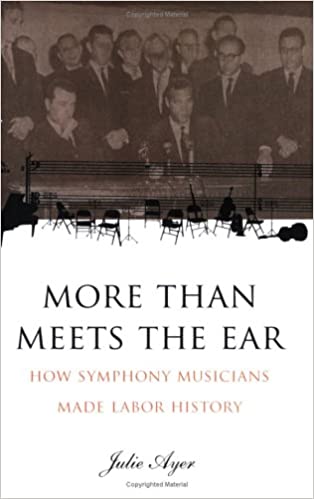
More Than Meets The Ear: How Symphony Musicians Made Labor History by Julie Ayer
Julie Ayer is the assistant principal second violin with the Minnesota Orchestra. After a relatively short but stressful employment with the Houston Symphony after music school, she joined the then-Minneapolis Symphony in 1976 and has been there ever since. Beginning with that early stint in Houston, she gradually became more and more involved in committee work, including labor relations, ICSOM delegate service, and general activism and muckraking. She has been researching and writing this book for a number of years. It was worth the wait.
What Ms. Ayer has written amounts to more than just a history of ICSOM, more than just a history of the Minnesota Orchestra, and more, even, than a history of the AFM. It is a microcosm of labor relations in the music industry during most of the twentieth century.
In discussing the importance of ICSOM, Ms. Ayer quotes an article written by one of the early editors of Senza Sordino. In the article, Henry Shaw wrote:
To tell what has transpired since 1962 should become a part of new member orientation. It must be emphasized that ICSOM is an investment and it must be protected. Perhaps an occasional reminder of difficulties that had to be dealt with is in order, along with the admonition that history can surely repeat itself where complacency becomes the order of the day.
That sentiment is reflected too in Ms. Ayer’s description of the origins of her fascination with the labor history of symphony musicians. She writes:
When I joined the Houston Symphony Orchestra in the winter of 1976, I had no idea of the problems ready to erupt there. During my brief membership in that orchestra, my eyes were opened to the basic principles of musicians’ committee involvement, the importance of speaking with one voice, unanimity of purpose, and strong representative leadership. I realized quickly that no amount of violin practice or freelance experience could have prepared me for all of the nonperformance obligations in an orchestra. Through the impressive example of the Houston musicians, I began to understand the fundamentals of organization, committee work, and labor negotiations. I also began to learn of the history of this labor struggle, not only for the Houston musicians, but for musicians all over the United States and Canada. Six months after my first concert, the Houston Symphony Orchestra management locked out the musicians in a bitter labor dispute. I regretfully left the orchestra to resume auditioning.
The description resonated with me, as I was called in toward the end of that horrible lockout in 1977 to help fashion a settlement that nobody liked, but without which, in my opinion, the orchestra would have folded.
Ms. Ayer gives an eminently readable history of the AFM—including the notorious “Petrillo years,” the agonizing birth of ICSOM, the issue of civil rights, and the bias against women. In addition, she has attached summaries of each negotiation, the participants, and the results of every labor negotiation in the Minnesota Orchestra since 1965. Ms. Ayer describes, in some detail, a number of the more bitter battles with the AFM (e.g., Petrillo and the Chicago Symphony musicians), between musicians and their locals (e.g., the endless battles in Cleveland), and the extraordinary efforts to finally get the musicians of the Boston Symphony Orchestra under union contract. She also identifies and describes the efforts of the founders and early officers of ICSOM. These include the first chairman, George Zazofsky (ironically, from the BSO), the first vice-chairman and second chairman, San Denov (from the Chicago Symphony, who has himself written about his involvement in the deposing of Petrillo and his days as an ICSOM officer), as well as others too numerous to mention here.
In sum, it is indeed a worthwhile read for all labor activists, whether in the music industry or not. I believe it should be required reading for young musicians in conservatories who need to understand that there is one more B after Bach, Beethoven, and Brahms that stands for Bread. Indeed, the book is a perfect kickoff for the implementation of the recent ICSOM resolution calling for the gathering and preservation of as much oral history of ICSOM as is still obtainable from those who founded and nurtured the organization from its earliest days.





